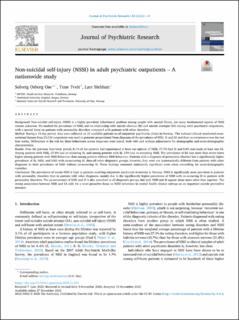| dc.description.abstract | Background:
Non-suicidal self-injury (NSSI) is a highly prevalent behavioural problem among people with mental illness, yet many fundamental aspects of NSSI remain unknown. We studied the prevalence of NSSI, and its relationship with suicide ideation (SI) and suicide attempts (SA) among adult psychiatric outpatients, with a special focus on patients with personality disorders compared with patients with other disorders.
Method:
During a 14-day period, data were collected on all available patients in all outpatient psychiatric clinics in Norway. This national clinical unselected cross-sectional dataset from 23,124 outpatients was used to generate proportional Venn diagrams of the prevalence of NSSI, SI and SA and their co-occurrence over the last four weeks. Differences in the risk for these behaviours across diagnoses were tested, both with and without adjustments for demographic and socio-demographic characteristics.
Results:
Over the previous four-week period, 8.1% of the patients had experienced at least one episode of NSSI, 17.3% had SI and 0.6% had made at least one SA. Among patients with NSSI, 27.8% had co-occurring SI, and among patients with SI, 13% had co-occurring NSSI. The prevalence of SA was more than seven times higher among patients with NSSI behaviour than among patients without NSSI behaviour. Patients with a diagnosis of personality disorder had a significantly higher prevalence of SI, NSSI, and NSSI with co-occurring SI, than all other diagnostic groups; however, they were not systematically different from patients with other diagnoses in their prevalence of NSSI without co-occurring SI. These findings remained statistically significant even when controlling for socio-demographic variables.
Conclusions:
The prevalence of recent NSSI is high in patients receiving outpatient psychiatric treatment in Norway. NSSI is significantly more prevalent in patients with personality disorders than in patients with other diagnoses, mainly due to the significantly higher prevalence of NSSI with co-occurring SI in patients with personality disorders. The co-occurrence of NSSI and SI is also prevalent in all diagnostic groups, but both NSSI and SI appear alone more often than together. The strong association between NSSI and SA calls for a more proactive focus on NSSI behaviour in mental health clinical settings as an important suicide preventive measure. | en_US |

